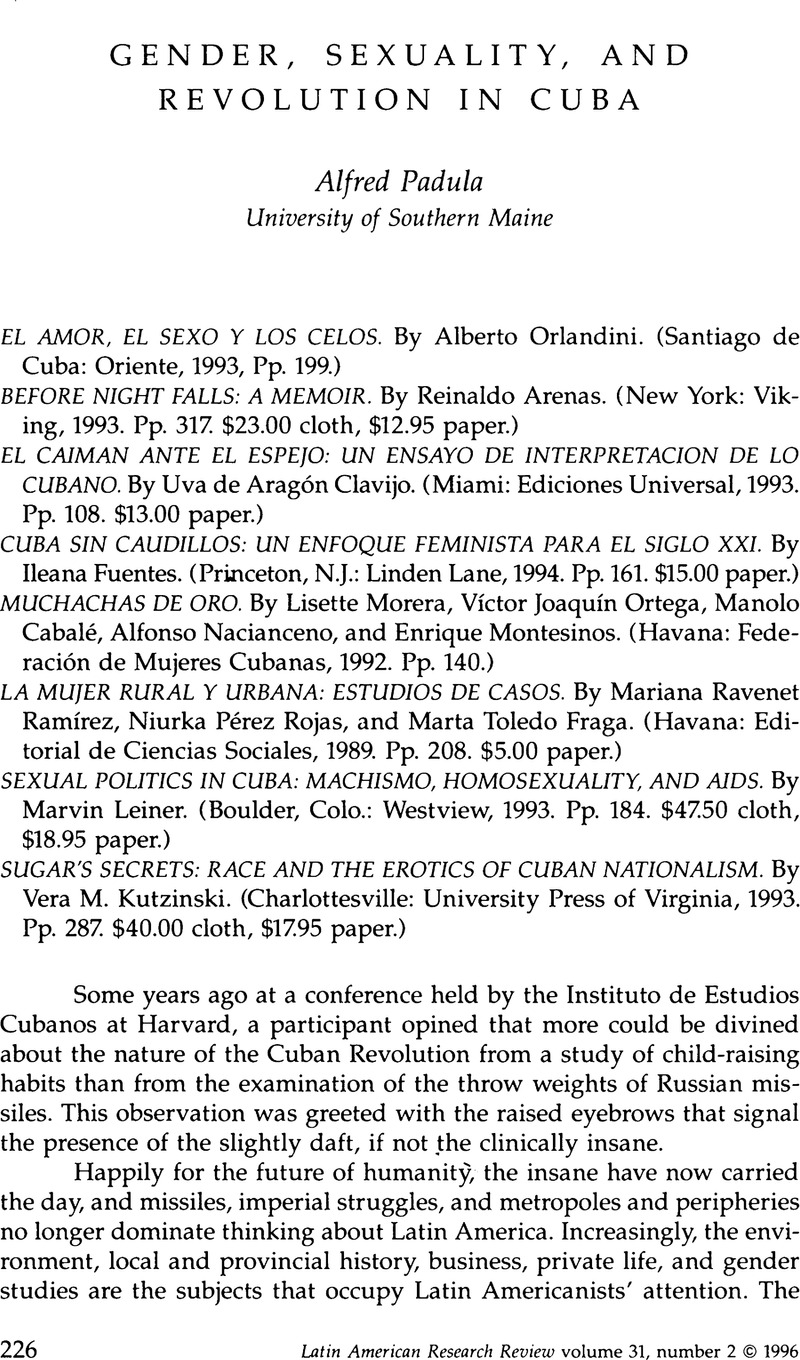Article contents
Gender, Sexuality, and Revolution in Cuba
Review products
Published online by Cambridge University Press: 05 October 2022
Abstract

- Type
- Review Essays
- Information
- Copyright
- Copyright © 1996 by the University of Texas Press
References
1. Niurka Pérez Rojas is a leading commentator on co-ops. See, for example, Carmen Diana Deere, Mieke Meurs, and Niurka Pérez, “Hacia una periodización del proceso de colectivación cubana: Incentivos cambiantes y respuesta campesina,” Cuban Studies, no. 22 (1992):115–50.
2. For a more ample discussion, see Lois Smith and Alfred Padula, Sex and Revolution: Women in Socialist Cuba, Oxford University Press, forthcoming.
3. Visit by the author in June 1994.
4. For more than two decades, the substantial fashion sections of the FMC's magazines Muchachas and Mujeres featured slim, white, Nordic-looking models in page after page of dress designs and fashion. Not a mulata in sight—shades of Xuxa! Even more ironic for a worker's republic, the clothing was intended almost exclusively for play, not for work. In an 1986 interview, the editor of Mujeres explained that many of the designs had been lifted from Soviet magazines, which had previously copied them from fashion magazines of the West.
5. One thinks of Che Guevara's observation during a firefight with the forces of dictator Fulgencio Batista in 1956 that war was “a virile sport.” Che was shot in the neck shortly thereafter.
6. Reminiscing about his youth, sociologist Nelson Valdés recalled that Cuban boys used to play a game in which a ball is thrown as hard as possible at another player. The object was to inflict pain and to resist showing pain. The game is still being played in Cuba. Interview with Valdés, Havana, June 1994.
7. Cruz Varela observed at one point that Fidel Castro was not her father. She was later beaten up and imprisoned for her remarks and for her role in human rights activities. Thereafter, she traveled to the United States. During 1995 she was on a year-long “sabbatical” in Puerto Rico.
8. Marvin Leiner, Children Are the Revolution: Day Care in Cuba (New York: Penguin, 1978).
9. So that men could have this “masculine edge,” women would have to do more ironing.
10. Krause returned to her native Germany in the early 1990s. A remarkable person, she pioneered in sex education in the Hispanic world. Krause has been fearless in expressing her sometimes controversial views. Much of the sex education materials that she used in the 1970s and 1980s were translations of German material, which gave rise to some resentment. The newer material, like that in Orlandini's book, is written by Cubans.
11. The most recent data show that 210 persons have died from AIDS in Cuba and 1098 are currently HIV-positive. See Pablo Alfonso, “210 muertos por SIDA,” El Nuevo Herald (Miami), 30 Dec. 1994, p. 3A.
12. It is curious that the illustrations in Orlandini's El amor, el sexo y los celos (like those in Muchachas de Oro) show no mulatos or blacks.
- 1
- Cited by




